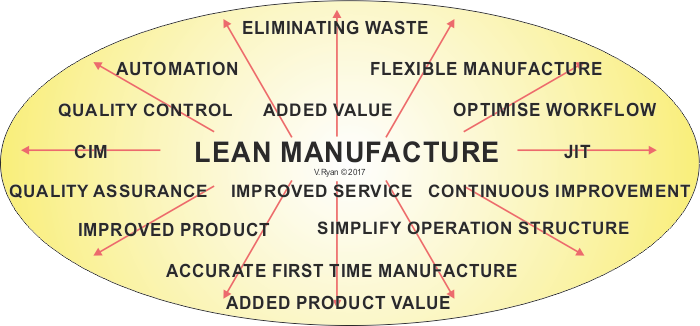| CLICK HERE FOR INDEX PAGE |
| INTRODUCTION TO LEAN MANUFACTURING |
| V. Ryan © 2017 |
|
| Lean manufacture is often regarded as being pioneered by Japanese companies, such as Toyota in the 1990s. It has also been developed by US companies such as Dell and Xerox. This system or philosophy, has been adopted by thousands of companies, is now being implemented around the world. |
COMPARISON - JUST IN TIME (JIT) AND LEAN MANUFACTURE |
Lean Manufacturing and Just in Time, are often regarded as the same, although they different in many ways. JIT concentrates on the efficient use of time and storing small amounts of stock/components, for use on the production line. On the other hand, although efficiency is a core principle to Lean Manufacture, it must add value to the product and benefit the customer. In this way, JIT contributes to the Lean Manufacturing system. Each principle must result in added product value, from the customer point of view. An example of this is seen in the development and manufacture of a smart phone. Potential customers want long battery life, fast internet connection, a high definition camera, all at an affordable price. Lean Manufacturing focuses on the customer needs, as a way of adding ‘value’ to the product, at the development and production stage. |
 |
Lean Manufacturing and it’s tried and tested set of principles, are aimed at reducing the cost of manufacture, scaling down or eliminating waste and improving levels of productivity, with the product continually improving. It involves full commitment by everyone in a company / organisation. It is a system or philosophy, operated by manufacturing industry, retail business, distribution and a range of other business types. It can be described as a combination of different production systems and industrial principles. These include ‘just in time, continuous improvement, accurate first time manufacture, flexible manufacturing, automation (CIM) with human participation, quality control and quality assurance. The optimisation of the flow of work, along with simplifying the company operational structure and reducing waste at every stage, are also core principles. |
LEAN MANUFACTURE - KEY FEATURES DIAGRAM |
 |
| CLICK HERE FOR RESISTANT MATERIALS INDEX PAGE |